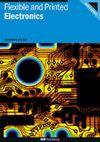Inkjet-printed heater on flexible substrates for low voltage applications
IF 3.2
4区 工程技术
Q3 MATERIALS SCIENCE, MULTIDISCIPLINARY
引用次数: 0
Abstract
Flexible heaters (FHs) have applications ranging from defoggers to flexural warmers, food processors, and thermotherapy. Printed FHs are particularly of interest as they offer unique advantages like high resolution, customization, low cost, and ease of fabrication. Here, we report printed FHs on polyethylene terephthalate substrate. The heater design is optimized to operate on a low voltage of five volts and yield high temperatures with a uniform temperature distribution across the surface. The heater has a fast response time of 15 s to reach its maximum temperature and does not show any degradation in performance after three months of operation. The heater maintains its temperature after continuous use for two hours and exhibits a minimum change in temperature upon bending. We have also developed and tested designs for zone heaters and nano heaters, where zone heater is suited for applications requiring heating in specified locations on a surface only. Whereas nano heater has an area of 1 mm2 and can produce high temperatures in this small area. Finally, we developed similar printed heaters on paper and polyimide (PI) substrates as well. Paper-based heater can achieve a temperature of 210 °C and can be used in disposable applications due to its low cost, whereas PI heater can achieve a temperature of 380 °C and is suitable for attaining high temperatures. These results manifest the use of FHs for various practical applications.用于低电压应用的柔性基板上的喷墨打印加热器
柔性加热器(FHs)的应用范围很广,从除雾器到挠性加热器、食品加工机和热疗。印刷型柔性加热器具有分辨率高、可定制、成本低和易于制造等独特优势,因此尤其受到关注。在此,我们报告了在聚对苯二甲酸乙二醇酯基底上打印的加热管。加热器设计经过优化,可在 5 伏特的低电压下工作,并在整个表面产生温度分布均匀的高温。加热器达到最高温度的快速反应时间为 15 秒,运行三个月后性能没有任何下降。加热器在连续使用两小时后仍能保持温度,弯曲时的温度变化最小。我们还开发并测试了区域加热器和纳米加热器的设计,其中区域加热器适用于只需要在表面上指定位置加热的应用。纳米加热器的面积为 1 平方毫米,可在这一小块区域内产生高温。最后,我们还在纸和聚酰亚胺(PI)基底上开发了类似的印刷加热器。纸基加热器的温度可达 210 ℃,由于成本低廉,可用于一次性应用,而聚酰亚胺加热器的温度可达 380 ℃,适用于达到高温。这些结果表明,纤维增强塑料加热器可用于各种实际应用。
本文章由计算机程序翻译,如有差异,请以英文原文为准。
求助全文
约1分钟内获得全文
求助全文
来源期刊

Flexible and Printed Electronics
MATERIALS SCIENCE, MULTIDISCIPLINARY-
CiteScore
4.80
自引率
9.70%
发文量
101
期刊介绍:
Flexible and Printed Electronics is a multidisciplinary journal publishing cutting edge research articles on electronics that can be either flexible, plastic, stretchable, conformable or printed. Research related to electronic materials, manufacturing techniques, components or systems which meets any one (or more) of the above criteria is suitable for publication in the journal. Subjects included in the journal range from flexible materials and printing techniques, design or modelling of electrical systems and components, advanced fabrication methods and bioelectronics, to the properties of devices and end user applications.
 求助内容:
求助内容: 应助结果提醒方式:
应助结果提醒方式:


